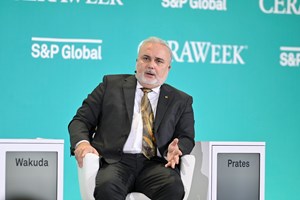CERAWeek by S&P Global: Strategic choices in a net zero world
During the late morning of last Monday, March 18, a CERAWeek session entitled “Strategic Choices in a Net Zero World” prompted a lively discussion among several panelists. Among the panelists were Liza Mustapha, Executive Vice President & Group Chief Financial Officer, Petronas; Jean Paul Prates, Chief Executive Officer, Petrobas; and Meg O’Neill, Chief Executive Officer & Managing Director, Woodside Energy.
No net zero without Asia. Mustapha took the fore on the opening discussion, establishing the common question of how to avoid a transition that is difficult or uneconomic. As an executive for Petronas, Mustapha emphasized the key role that Asia would have to play in the transition, going so far as to say, there is “not net zero without Asia,” referencing that the region constitutes 60% of global emissions, as well as a 40% chunk of future energy consumption. She stressed that, at the time of speaking, 150 million people in Asia still have no access to electricity, as well as the fact that any transition would, itself, also be energy intensive.
O’Neill similarly noted the importance of Asian markets. Australian gas will have a large role to play in decarbonization, she said, noting that China’s middle class currently sits at 400 million people, and the country aims to double that figure in the coming years—all of which will increase energy costs.
And on the subject of cost, O’Neill was quick to point out that energy products need to be affordable. In the wake of the invasion of Ukraine, the LNG market was thrown into chaos, with the shortage of gas tightening the market enough to drive some regular LNG consumers back to coal. This, of course, resulted in greater greenhouse gas emissions, making it plain that gas has a pivotal role in reducing them. Even more important is the collaboration between producers and consumers—as Mustapha aptly put it, “If you want to go fast, go alone. If you want to go far, go together.”
When asked about renewables, Prates of Petrobras also referenced earlier points on the need for affordable new sources of energy. He also added that any potential energy source needs to be substantial, rather than a “passing fad.” Energy poverty is a major concern in the overall energy transition, and in Prates’ view, it creates a considerable dividing line when determining policy on the subject. The transition should provide benefits as well; for example, electrification of vehicles should lead to opportunities for public transportation, like electrified public buses.
However, Prates also noted that for the 2050 energy mix, a large portion is still projected to be oil and gas, with the logistics of the transition centered around easing off of oil eventually. He highlighted that the world “always will need liquid energy,” even if he holds that local energy sources will be the main component of the energy transition. To that end, he noted Petrobras’ goals were to focus on offshore operations, as well as liquid fuel sources, such as hydrogen and LNG.
Policies and finance. When asked about some of the logistics of the energy transition, Mustapha echoed many of the sentiments that the other panelists had mentioned: energy transition sources need to be reliable, affordable and should have the ability to be upscaled in operations and production. She specifically highlighted the role of capital in scaling up existing investments into green energy, as well as decarbonization efforts. For Petronas, she expressed particular frustration at the inability to access competitive financing, which poses a serious delay to scaling up energy transition and decarbonization projects. Not only would financing speed up this process, but it would also afford the company’s customers some savings down the line, as well.
O’Neil agreed with the sentiment of capital’s critical role in the energy transition, though she advocated a more conservative route. The Woodside executive emphasized a strong focus on strategic capital usage, including protecting the company’s credit rating and bolstering its ability to resist price shocks and market unpredictability. Even so, O’Neil mentioned plans for significant investment in new energy, such as hydrogen, as well as decarbonization efforts, like Carbon Capture and Storage (CSS). Pointing to risk assessments the company conducted on both new energy sources and conventional oil and gas, she noted that both show market risks. Yet, the company’s aim is to be disciplined on achieving targeted rates of return on its investments, even as the firm devotes spending to green projects.
Prates similarly advocated fiscal responsibility with low-risk investments, rather than jumping into new fuels right away, like hydrogen. He noted that no one is in a better position to drive the energy transition than oil and gas companies, yet he stressed that more likely, the energy transition will be more of a transformation. The goal is to provide energy in a responsible way that allows low risk to investors, thus generating more capital in a stable way.
Energy transition challenges. When asked about the biggest challenges and opportunities of 2025, O’Neil referenced the timeline of energy transition being a particular frustration. While the idea that the transition can happen at an unreasonable pace persists, she stressed that a more pragmatic view is necessary—one that dives beyond a surface-level narrative to the complex story underneath. She noted that while some are willing to pay more for the energy transition, the world at large still wants only cheap energy. Even so, O’Neil sees the coming year as an opportunity to continue providing products to customers while also taking steps toward decarbonization, methane reduction, and other goals. When that sector of people willing to pay more for energy grows, then, O’Neil said, more progress will occur.
Prates also urged caution pursuing certain technologies and specific targets for countries that cannot reasonably achieve them. Imposing those sorts of restrictions, he said, would be ignoring the responsibility toward customers and people dependent on that energy. The focus, in his view, should continue to be emissions reduction, as well as pursuing local energy sources, which he argued will provide greater comfort and fewer conflicts and disputes. As the moderator of the panel summed it, “Energy is not the enemy, emissions are the enemy.” Prates agreed with this statement and added that to achieve those goals, responsibility is needed to avoid disaster and high prices.
Mustapha closed the panel with her answer, noting that in the years to come, the industry doesn’t yet have the answers but should have bold and large ambitions, nonetheless. Collaboration, accelerated technology development and financial backing will all need to come together to calibrate the balance of risk and reward needed by the industry to move forward. She stressed the importance of long-term results, rather than short-term ones, as well as how collaborative measures will be key to attaining these results in the years to come.




